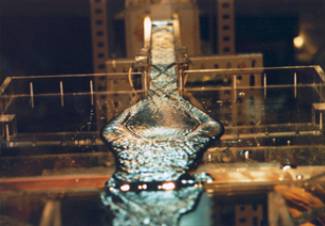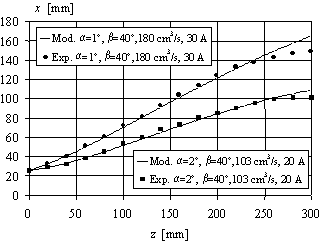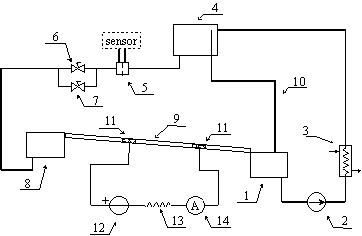

Photograph of the flowing out jet.
Predicted and measured
widenings.

Electromagnetic
Shaping of a Liquid Metal Jet
In cooperation with the Dept. of
Mechanical Engineering & Sciences,
Tokyo Institute of Technology, (Prof. R.Yamane)
·
The shape of a mercury jet under a non-uniform transverse magnetic field
is studied.
·
The aim of the study is to determine the widening of the free surface of
the jet and to demonstrate the possibility of a magnetic control.
· Applications of this research are in the production processes of metal sheets and particularly in the use of an electromagnetic wiping force in the hot dip galvanizing lines.
|
|
|
|
Photograph of the flowing out jet. |
Predicted and measured
widenings. |
|
|
|
|
|
|
The experimental apparatus, shown schematically in the figure, consists of a channel (9), a feeding cycle and a simple electrical circuit. The system is filled in with mercury (about 12000 cm3) from the lower reservoir (1). The metal is pushed to the upper reservoir (4) by means of a centrifugal pump (2), with a mass flow rate of 0.04 m3/min (1450 rpm, 1.5 kW), actuated by a three-phase asynchronous motor (4 poles, 1.5 kW, 200 V, 50 Hz). To maintain the fluid at a constant temperature, a water jacket heat exchanger (3) is attached to the mercury loop. From the upper reservoir the liquid flows out because of gravity. The flow rate is adjusted with the valves (6) and (7): (6) is a stop valve and (7) is a needle valve used for regulation.
The
sensor (5) is a calibration device used to measure the flow rate: it works using
the orifice method. The pressure drop Dp at the ends of the orifice
depends quadratically on the mass flow rate. The signal, in Volts, got from a Dp transducer is measured and
used to estimate the mass flow rate. Once the feeding reservoir (8) is filled
up, the mercury flows down on the channel and gathers in (1). The pipe (10) is
needed when the flow on the channel must be stopped, without switching off the
pump.
The
DC voltage source (12), a three-phase rectifier (30 A, 50 V), in series with a
resistance (13) and an amperometer (14), is connected with two copper electrodes
(11) at the ends of the channel. The flowing mercury closes the circuit. The
electric current (15¸30
A) flows in the mercury from the lower to upper electrode.